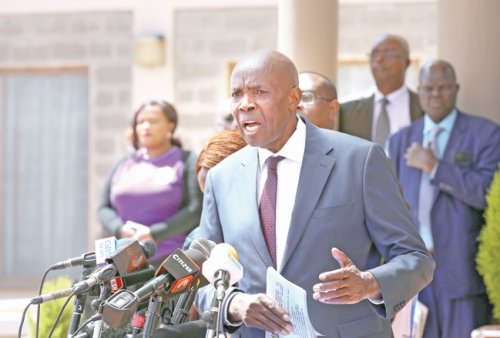The Ministry of Education has now roped in national government administrators as it moves to unravel the mystery of the missing 10,000 KCPE and KCSE candidates who failed to sit the examinations last year.
The number includes some 7,000 candidates who registered for but failed to write KCPE exam, as well as some 3,685 others who equally registered for the Form Four exam only to vanish in to thin air.
This even as questions emerged over the criterion to be used to admit to Form One some 2,000 KCPE candidates who registered for the exam but never wrote it, only to be traced last month.
Education Cabinet Secretary Ezekiel Machogu had on Monday said 2,000 learners, who had been part of the 9,000 learners who missed the KCPE exam, had been traced and would be allowed to join Form One.
“I promised that the Kenya National Examinations Council (KNEC) will administer a supplementary exam for 9,000 candidates who failed to sit the exam. Upon a further audit of the number of candidates who actually failed to sit the exams, the council has only been able to trace 2,000 eligible learners,” said the CS.
Managed to trace
Machogu said the 2,000 learners would sit for the national primary exam while in Form Three, a move that has elicited condemnation from educationists who are questioning the criterion that would be used to admit them in Form One.
Education experts also laid blame on the Ministry of Education for failing to adequately plan well for such an eventuality.
Machogu had disclosed that the government had only managed to trace the 2,000 out of the 9,000, with the fate of 7,000 learners who failed to sit for the exam for various reasons remaining unknown.
President William Ruto had on the other hand directed investigation into the over 3,000 candidates who registered for the 2023 KCSE examination but did not sit the exams.
This is after Machogu revealed that the number of candidates that sat the examination was less by 3,685 compared with the number that actually registered to sit.
Inflating figures
“I am concerned with the number that failed to sit the examination as it would point to a situation where some schools could be inflating the figures of registered candidates to meet the minimum threshold of 30 candidates required to be enlisted as an examination centre,” said the CS.
“I, therefore, direct the relevant Directorate of Quality Assurance to work with the Kenya National Examinations Council to investigate the 3,685 candidates who failed to sit the 2023 KCSE examination with a view to unearthing their true identity and whereabouts,” the CS directed.
Yesterday, the Ministry of Interior announced that it will work closely with the Ministry of Education to ensure 100 percent transition and that all candidates are accounted for.
The National Government administrators (NGAOs)—Deputy County Commissioners, Assistant County Commissioners, Chiefs, and Assistant Chiefs—help in locating the candidates in their respective jurisdictions.
“Education officials have the details of the candidates and once it has been shared with us, we will work closely with them in identifying the candidates and establishing the reasons why they did not sit the exams,” an Interior ministry official said.
Apart from identifying the candidates and establishing the reasons behind their not sitting the exams, they will also be expected to engage other law enforcement agencies and education field officers to ensure the candidates advance to the next step.
The ministry will also put measures in place to ensure young girls are not exposed to risky indulgences that lead to teen pregnancies among other issues.
Reports indicate there have been increasing cases of drug and substance abuse in some parts of the country
Internal Security Principal Secretary Dr Raymond Omollo had earlier said that there was an urgent need to deal with school dropouts which have been blamed for an increase in crime and a lifetime of missed opportunities.
The PS said there were growing concerns over worsening attrition rates, which not only led to poverty, social exclusion and ill health but also crime and delinquency.
“These attrition rates are becoming worse each year, and there is a clear nexus between dropout rates and crime rates as well as social disadvantages and early marriages. This pattern is also perpetuating a cycle of poverty among these young boys and girls,” he said.
Scholars have also been challenged to step up and take a more engaged role in solving the imposing school dropout dilemma.
Source: K24 TV
